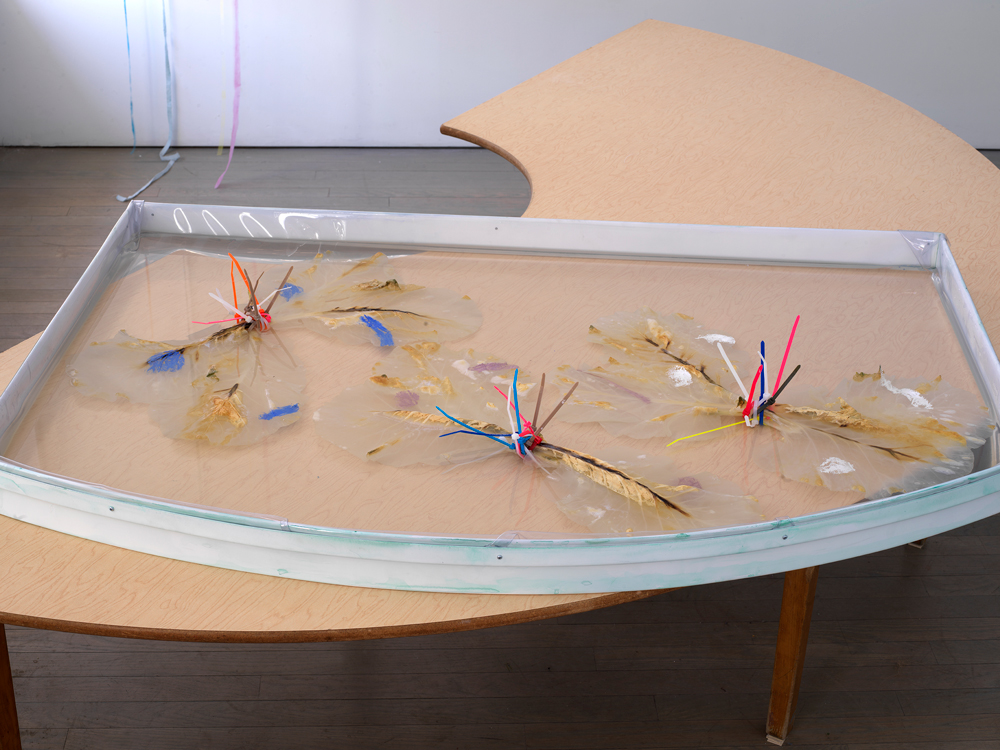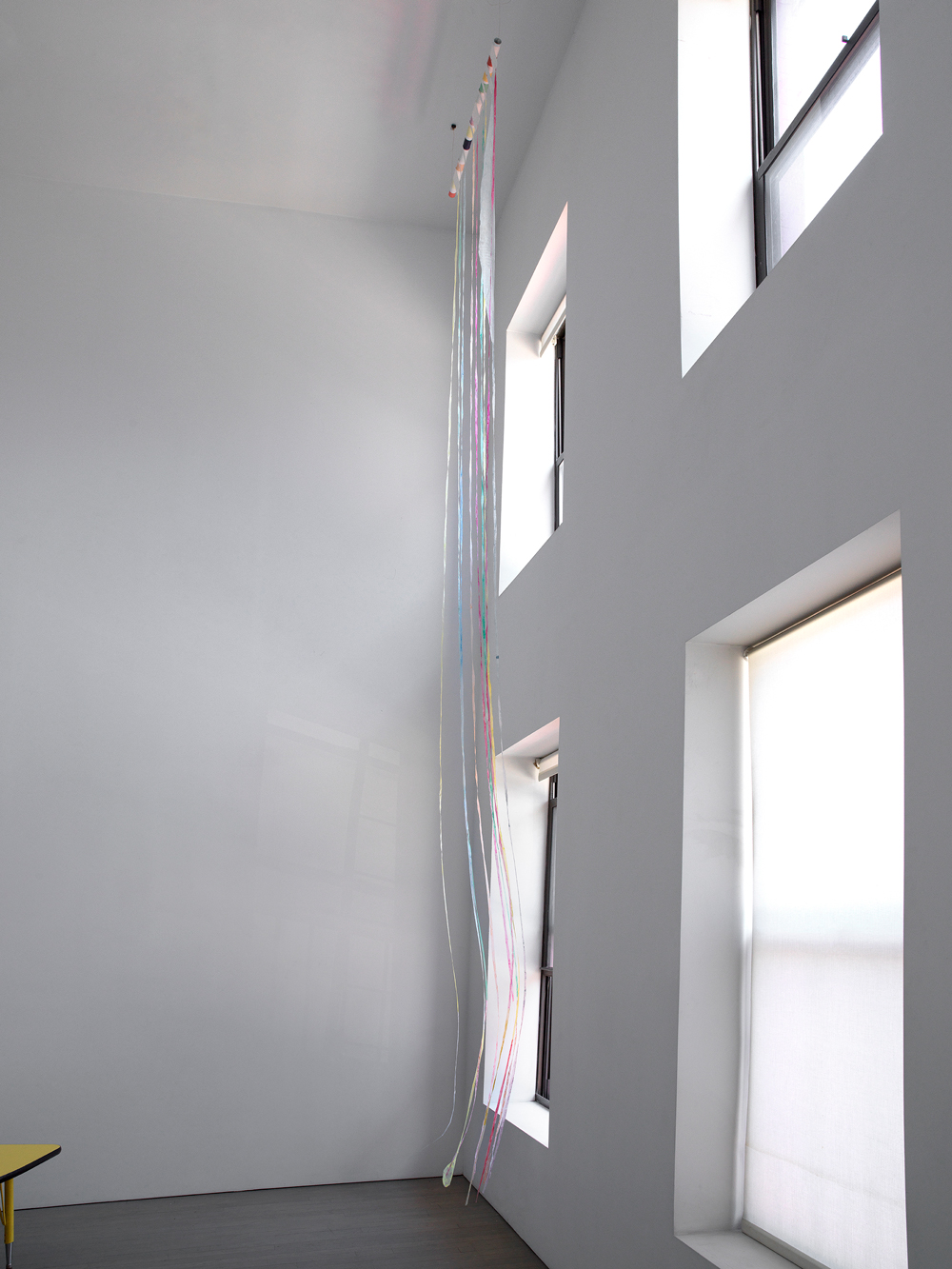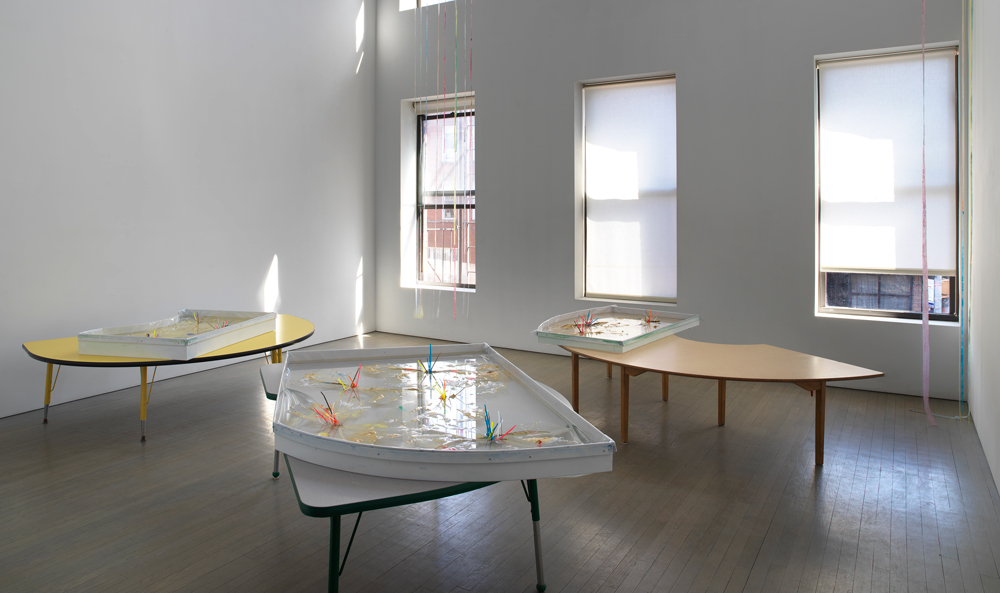Tim Simonds explores the whimsical and political dimensions of pedagogy in his sparse installation of sculptures and drawings at Cathouse Proper. With large trays of bleached-out collard greens on top of semicircular children’s tables, the main room of the gallery feels like a Montessori meth lab—instructional and devious at the same time. All of the gallery lights have been removed and a large window remains open, allowing the breeze to enter the room and rustle the cluster of long, thin ribbons hanging from the ceiling. The space feels calm, and this atmosphere encouraged me to linger with these enchanting objects. These works possess a quality of self-aware meandering, committed yet indeterminate.

Teachers Monarchs #1 (2020) watercolor, graphite, pastel on paper
Six unframed watercolors are pinned directly to the wall along the corridor that leads into the gallery. Short dashes and dots of oil pastel stand out from the more muted brushwork and pencil beneath. Loosely drawn butterflies fill these dimpled sheets of paper. Casual washes of soft colors enliven the wing shapes, with lots of elegant neutrals. In some places the pigments pool and separate from each other, creating gorgeous little gradients. At a distance, it becomes clear that the marks of oil pastel form rudimentary faces—two dots and a curving line—across the wings of these flowy creatures. Recognition of the butterflies and faces happens quickly, but they are floating in an undefined plane and so it’s just as easy to drift into a reverie of color and shapes. These playful drawings introduce the symbolic language of the exhibition, which enters a much stranger register in the main room of the gallery.

Teachers Monarchs: Vents alighted on activity table #2 (2021) woodgrain activity table acquired from a day care center in Rock Tavern, NY, steel, plastic, zip ties, water, paint, traces of bleach, watercolor, collards
Three curved tables stand low to the ground in a room with double-height ceilings with natural light flooding in from six large windows. Each table has distinct finishes, but their design manifests the same intention: to distribute students along the outer arc while placing the teacher at the center. Their form proposes a gentle pulpit from which instruction can radiate outwards, a tender hierarchy. On top of each table sits a large tray-like sculpture made from clear plastic sheeting draped over a steel frame. These shallow containers have three straight edges and one curved side, and they each overlap the edges of the table beneath. Simonds titled these works Teachers Monarchs: Vents alighted on activity table #1-3 (2021), and they contain several clusters of translucent collard greens in shallow pools of water. A tangle of colorful zip ties binds together the stems of four leaves into the familiar shape of a butterfly. These broad leaves have lost almost all their color, with only a few pale yellow and tan patches. The stems are brown with occasional traces of dark green. Simonds accents this ghostly floating vegetation with thick lines of oil pastel, whose color seems unchanged by whatever reaction stripped the collards of their hue. With an unruly knot of colorful plastic straps at the core, these creatures look alien but also elegant—bathed in soft light. The clear plastic allows the surfaces of the ‘activity tables’ to show through, blending with the textures of the leaves and their liquid. One of the tables features a faux wood grain pattern. It feels strange to see the warm glow of fake wood through veins of a translucent collard. The arrangement has the internal logic of alchemy and mysterious transformations require a tolerance for unconventional combinations of ingredients. Each of these parts coexists surprisingly well with its companions, asking very little other than to share space and soak up the abundant glow of the windows.

Teachers Monarchs: Vents alighted on activity table #3 (2021)
yellow activity table borrowed from JEI Learning Center Bensonhurst, steel, plastic, zip ties, water, paint, traces of bleach, watercolor, collards
Three works consist of home-made ribbons hanging from the wall or ceiling in varying configurations. Soft, splotchy colors cling to these thin strips of plastic and tracing paper. Several seams are visible, and each of the strands I examined changed colors at least once. The most animated of these sculptures, Sound of Teaching (Leashes): The students act and the teacher has the illusion of acting through the actions of the students (2020) hangs by the open window. Nearly 20 feet of these tiny dangling streamers drift about and then heave themselves around when a gust comes through. This work enacts the collective breath of the room and manifests continual, unplanned movement. As with the bleached greens tied together crudely, Simonds sets up the conditions for spontaneous interactions, and then removes himself from the picture. His vision involves setting parameters more than delivering a fully rendered whole, inviting viewers to pronounce the syllables that his work insinuates.

Sound of Teaching (Leashes): The students act and the teacher has the illusion of acting through the actions of the students (2020)
acrylic paint, tracing paper, plastic film, neopastel, watercolor, metal
One of the reasons that education sparks such vigorous political debates is that teachers cannot avoid becoming role models to their students. Even the most egalitarian educators must confront the power of their example. The shape of pedagogy must account for the power of the teacher while also keeping it in check so as to avoid patterns of imitation. That all of Simonds’ sculptures appear autonomous, even from their maker, reflects his commitment to the agency of his viewer and his students. The abundance of translucent, transparent or reactive materials steers us towards the interdependence of these phenomena, while still allowing us our position as individuals. Moments where we can hold both of these concepts simultaneously—our agency and our mutual dependency—are rare, but thankfully this show provides just the right conditions.
Tim Simonds
Teachers Monarchs and a sound of teaching
At Cathouse Proper
Brooklyn, New York
extended through May 2


